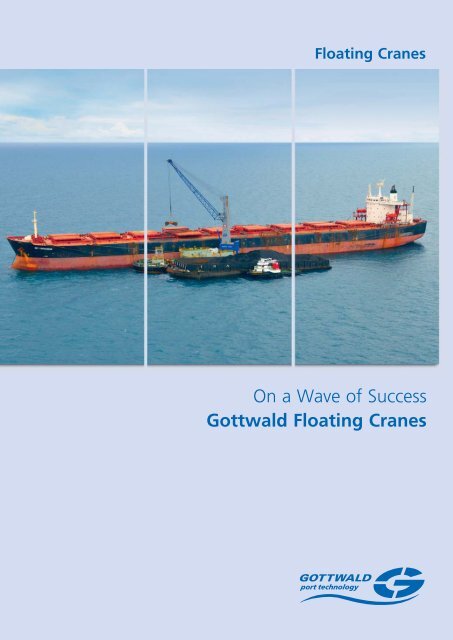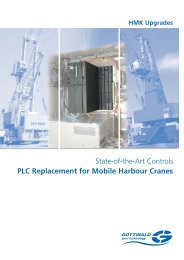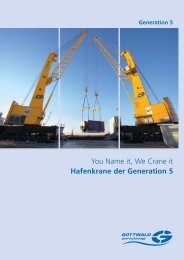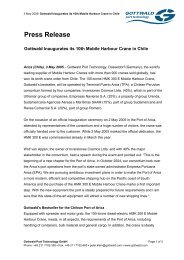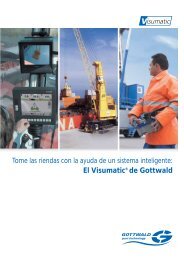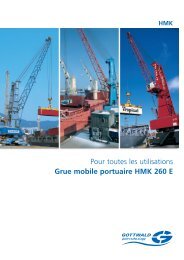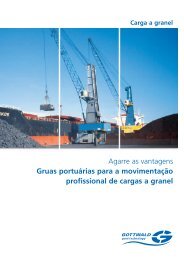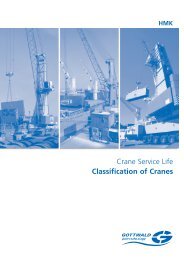On a Wave of Success Gottwald Floating Cranes - Gottwald Port ...
On a Wave of Success Gottwald Floating Cranes - Gottwald Port ...
On a Wave of Success Gottwald Floating Cranes - Gottwald Port ...
Create successful ePaper yourself
Turn your PDF publications into a flip-book with our unique Google optimized e-Paper software.
<strong>Floating</strong> <strong>Cranes</strong><br />
<strong>On</strong> a <strong>Wave</strong> <strong>of</strong> <strong>Success</strong><br />
<strong>Gottwald</strong> <strong>Floating</strong> <strong>Cranes</strong>
2<br />
Waterway Cargo-Handling on the Move<br />
<strong>Gottwald</strong>‘s Barge-Mounted Mobile Harbour Crane Technology<br />
Today‘s cargo volumes are more than<br />
many ports can handle with their<br />
present infrastructure. In some cases,<br />
the quays are approaching their<br />
capacity limits and can barely cope<br />
with the ever increasing ship sizes.<br />
However, for a number <strong>of</strong> terminal<br />
operators, the investment costs and<br />
the risks involved in expanding their<br />
present infrastructure are simply too<br />
high. A different solution is needed<br />
both to prevent cargo-handling<br />
bottlenecks and, at the same, provide<br />
a long-term flexible response to<br />
fluctuations in demand and longerterm<br />
market developments.<br />
<strong>Gottwald</strong> <strong>Floating</strong> <strong>Cranes</strong><br />
This is where <strong>Floating</strong> <strong>Cranes</strong> from<br />
<strong>Gottwald</strong> <strong>Port</strong> Technology come in.<br />
<strong>Gottwald</strong> <strong>Floating</strong> <strong>Cranes</strong> <strong>of</strong>fer many<br />
attractive benefits:<br />
■ autonomy<br />
■ mobility on water<br />
■ comparatively low specific<br />
in vest ment cost and<br />
■ short delivery time.<br />
And <strong>of</strong> course, with <strong>Floating</strong> <strong>Cranes</strong>,<br />
there is no need for the purchase <strong>of</strong><br />
additional land or the construction <strong>of</strong><br />
new quays, involving lengthy approval<br />
procedures and time-consuming construction<br />
work.<br />
<strong>Gottwald</strong>‘s <strong>Floating</strong> <strong>Cranes</strong> benefit from<br />
the proven leading-edge technology<br />
used a thousand times over around the<br />
world in <strong>Gottwald</strong> Mobile Harbour<br />
<strong>Cranes</strong> and use the same assemblies<br />
from the slewing ring up
<strong>Gottwald</strong> <strong>Floating</strong> <strong>Cranes</strong>, available<br />
as Harbour Pontoon <strong>Cranes</strong> and<br />
<strong>Port</strong>al Harbour <strong>Cranes</strong> on barges,<br />
are used<br />
■ for ship-to-ship handling<br />
■ for ship-to-shore handling<br />
■ in ports and sheltered waters<br />
■ on rivers<br />
■ in coastal waters and on the<br />
open sea.<br />
Having the same proven leading-edge<br />
technology incorporated in <strong>Gottwald</strong><br />
Mobile Harbour <strong>Cranes</strong>, <strong>Gottwald</strong><br />
<strong>Floating</strong> <strong>Cranes</strong> naturally <strong>of</strong>fer all the<br />
same renowned strengths. Designed<br />
for all types <strong>of</strong> applications, <strong>Gottwald</strong><br />
<strong>Floating</strong> <strong>Cranes</strong> are obtainable in<br />
all the different <strong>Gottwald</strong> Harbour<br />
Crane variants.<br />
The cranes‘ diesel-electric drives,<br />
flexible choice <strong>of</strong> lifting gear, high<br />
lifting capacities and working speeds,<br />
and service-friendly design – all this<br />
ensures top efficiency and economy<br />
and a broad range <strong>of</strong> applications.<br />
The Barge – the Basis <strong>of</strong> Every<br />
<strong>Floating</strong> Crane<br />
In its <strong>Floating</strong> <strong>Cranes</strong>, <strong>Gottwald</strong><br />
combines its crane know-how with<br />
the expertise <strong>of</strong> third-party barge<br />
manufacturers. The customer can<br />
<strong>Gottwald</strong> <strong>Floating</strong> <strong>Cranes</strong> –<br />
the Right Package From a Single Source<br />
Crane maritime<br />
classification<br />
choose between a used barge,<br />
which can be modified if necessary,<br />
and a new one. And he can either<br />
order the barge himself or appoint<br />
<strong>Gottwald</strong> <strong>Port</strong> Technology to manage<br />
the whole project.<br />
Barge design<br />
package<br />
Crane maritime<br />
classification<br />
Barge<br />
Barge design<br />
package<br />
Crane maritime<br />
classification<br />
Crane pedestal Crane pedestal Crane pedestal Crane pedestal<br />
Crane Crane Crane Crane Crane<br />
Turnkey Solution<br />
<strong>Gottwald</strong> <strong>Floating</strong> <strong>Cranes</strong> are obtainable in all the different <strong>Gottwald</strong> Harbour Crane variants,<br />
so the concept is very flexible, covering all ship sizes, cargo types and handling rate<br />
requirements. <strong>Gottwald</strong> <strong>of</strong>fers a wide range <strong>of</strong> possibilities: from the supply <strong>of</strong> a crane<br />
only up to complete turnkey floating crane projects.<br />
3
4<br />
Ship-to-Ship Handling<br />
<strong>Gottwald</strong> Harbour Pontoon <strong>Cranes</strong> Boost Handling Rates<br />
<strong>Gottwald</strong> <strong>Floating</strong> <strong>Cranes</strong> can be<br />
used on different types <strong>of</strong> waterways,<br />
including those having no<br />
or few quays. This is the case on<br />
the Mississippi in the USA, where,<br />
in the <strong>Port</strong> <strong>of</strong> South Louisiana,<br />
not far from New Orleans, several<br />
<strong>Gottwald</strong> Harbour Pontoon <strong>Cranes</strong><br />
are employed in mid-stream operation.<br />
These Harbour Pontoon <strong>Cranes</strong>, all<br />
<strong>of</strong> which are 4-rope grab variants,<br />
tranship a wide range <strong>of</strong> bulk materials<br />
between ocean-going vessels and river<br />
barges. In demanding continuousduty<br />
operation, they achieve handling<br />
rates <strong>of</strong> up to 1,000 tonnes an hour.<br />
For cargo-handling companies<br />
operating in the port, such as<br />
St. James Stevedoring Partners L.L.C.<br />
and Associated Terminals, <strong>Gottwald</strong><br />
Harbour Pontoon <strong>Cranes</strong> are the<br />
ideal solution for replacing old,<br />
lower-performance equipment and<br />
for boosting mid-stream handling<br />
rates. Some major cargo handling<br />
companies have already modernised<br />
their fleets with <strong>Gottwald</strong> <strong>Floating</strong><br />
<strong>Cranes</strong> and are now pr<strong>of</strong>iting from<br />
significant technological advances<br />
which translate into real business<br />
benefits.<br />
Five <strong>Gottwald</strong> Harbour Pontoon <strong>Cranes</strong>,<br />
<strong>of</strong> which three HPK 330 EG machines<br />
and two G HPK 6400 B cranes, operated<br />
by St. James Stevedoring Partners L.L.C.<br />
handling coal and other bulk materials<br />
on the Mississippi<br />
■ Grab capacity: 50 tonnes<br />
at a radius <strong>of</strong> up to 31 m<br />
Maximum radius:<br />
- HPK 330 EG: 50 m<br />
- G HPK 6400 B: 51 m<br />
■ A8 classification as<br />
per FEM 1.001 for<br />
long service life<br />
■ Used for loading<br />
and unloading<br />
Panamax ships<br />
■ Barge dimensions:<br />
- 65 m x 22 m x 4.6 m<br />
- 76 m x 22 m x 4.9 m (2x)<br />
- 76 m x 22 m x 3.7 m (2x)<br />
All <strong>Gottwald</strong> <strong>Floating</strong><br />
<strong>Cranes</strong> used on the<br />
Mississippi to date are<br />
based on specially<br />
adapted used barges
6<br />
Ship-to-Shore Handling<br />
<strong>Gottwald</strong> Harbour Pontoon <strong>Cranes</strong> Offer Unparalleled Flexibility<br />
When space on the quay is limited,<br />
<strong>Gottwald</strong> Harbour Pontoon <strong>Cranes</strong><br />
can transfer the cargo direct from ship<br />
to shore, making land-based cranes<br />
unnecessary. Cost-intensive modification<br />
<strong>of</strong> the infrastructure can thus be<br />
avoided.<br />
<strong>Gottwald</strong> Harbour Pontoon <strong>Cranes</strong><br />
can also be used alongside existing<br />
handling equipment in order to share<br />
the workload at times <strong>of</strong> peak<br />
demand. And if a ship is unable to<br />
moor directly alongside the quay<br />
because the water is too shallow, a<br />
<strong>Gottwald</strong> Harbour Pontoon Crane can<br />
be used to bridge the gap between<br />
ship and quay, making it unnecessary<br />
to invest in expensive quay walls and<br />
deep-draught berths.<br />
A <strong>Gottwald</strong> Harbour Pontoon Crane<br />
is being put to very flexible use in the<br />
<strong>Port</strong> <strong>of</strong> Amsterdam. The G HPK 8200 B,<br />
owned by Rietlanden Stevedores,<br />
ope rates at the quayside, in mid-stream<br />
and in the waters beyond the locks.<br />
As a high-performance Generation 5<br />
<strong>Gottwald</strong> Harbour Crane, it is used<br />
primarily for handling imported coal.<br />
The barge itself was ordered for the<br />
customer by <strong>Gottwald</strong> and built by<br />
a Dutch shipbuilding company.<br />
■ G HPK 8200 B (Generation 5)<br />
■ Grab capacity:<br />
50 tonnes at a radius <strong>of</strong> up to<br />
43 m, maximum radius: 50 m<br />
■ A8 classification as per<br />
FEM 1.001 for long service life<br />
■ Used for unloading Panamax<br />
and Capesize ships<br />
■ Barge dimensions:<br />
50 m x 24.6 m x 4 m
The versatile <strong>Gottwald</strong> Harbour<br />
Pontoon Crane is towed quickly and<br />
safely to wherever it is needed<br />
The slew ring <strong>of</strong> the crane is<br />
mounted on a cylindrical pedestal<br />
integrated in the barge<br />
7
The barge has special mounts on which<br />
the hook rotator and grabs <strong>of</strong> various<br />
types and sizes can be set down<br />
Handling rate [tph]<br />
2,000<br />
1,750<br />
1,500<br />
1,250<br />
1,000<br />
750<br />
Handling Rates for the Current Range<br />
<strong>of</strong> <strong>Floating</strong> <strong>Cranes</strong>*<br />
* Handling rates are dependent on<br />
ambient and operating conditions<br />
HPK 260 EG<br />
HPK 170 EG<br />
The crane‘s barge is also equipped with a<br />
number <strong>of</strong> winches used for warping the<br />
<strong>Floating</strong> Crane alongside sea-going vessels and<br />
for warping river vessels alongside the barge<br />
Model 4<br />
Model 6<br />
Bulk carriers/vessel beams [m]<br />
Model 7<br />
Model 8<br />
12 25 32 45<br />
Barge/Coaster Handysize Handymax Panamax Capesize Bulker
Outside the locks <strong>of</strong> the North Sea Canal,<br />
the G HPK 8200 B is used for lightering large<br />
ocean-going vessels that are unable to enter<br />
the canal and the <strong>Port</strong> <strong>of</strong> Amsterdam area<br />
fully laden. The <strong>Floating</strong> Crane tranships coal<br />
onto barges, which then transport it to<br />
power stations along the Rhine.<br />
Moored at the quayside, the G HPK 8200 B<br />
tranships bulk cargo directly onto the quay.<br />
In mid-stream operation, it also transfers<br />
more coal from the still heavily laden<br />
ocean-going vessels to smaller barges.
8<br />
A Combination <strong>of</strong> Efficiency and Functionality<br />
<strong>Port</strong>al Harbour <strong>Cranes</strong> on Barge<br />
<strong>Gottwald</strong> <strong>Floating</strong> <strong>Cranes</strong> are dieselelectrically<br />
driven. It is also possible to<br />
make use <strong>of</strong> an external power source<br />
since <strong>Gottwald</strong> cranes already use<br />
electrical drive technology and the drive<br />
units can also be operated directly with<br />
power from the on-shore power supply.<br />
No wonder this environmentally-friendly<br />
drive system most commonly used in<br />
ports brings to the fore its advantages<br />
over other systems and is completely<br />
state-<strong>of</strong>-the-art.<br />
Two HSK 330 EG <strong>Port</strong>al Harbour <strong>Cranes</strong><br />
on barges transhipping coal at a pier in<br />
Charleston, SC, USA<br />
■ Track gauge: 13.4 m<br />
■ Grab capacity: 40 tonnes at<br />
a radius <strong>of</strong> up to 34 m,<br />
maximum radius: 50 m<br />
■ Used for unloading Panamax ships<br />
■ Barge dimensions:<br />
72.5 m x 19.5 m x 3.6 m
10<br />
Bulk Handling on the Open Sea<br />
<strong>Gottwald</strong> <strong>Floating</strong> <strong>Cranes</strong> up to 35 km <strong>of</strong>f the Coast<br />
The Generation 5 Harbour Pontoon<br />
<strong>Cranes</strong> supplied to PT Puteri Borneo<br />
Company and PT Indo Straits are<br />
taking <strong>Gottwald</strong>‘s <strong>Floating</strong> Crane<br />
technology to new places.<br />
In operation <strong>of</strong>f the Indonesian coast,<br />
these <strong>Gottwald</strong> <strong>Floating</strong> <strong>Cranes</strong> are<br />
used for open-sea transhipment <strong>of</strong><br />
export coal from barges to oceangoing<br />
vessels 35 km and 4 km <strong>of</strong>f<br />
the coast respectively, demonstrating<br />
the suitability <strong>of</strong> <strong>Gottwald</strong> <strong>Floating</strong><br />
<strong>Cranes</strong> for open-sea operation.<br />
Such cranes can be operated in<br />
winds up to force 9 Bft and with<br />
waves up to 2.5 m high. The wind<br />
pressure and swell give rise to<br />
additional heeling moments along<br />
with increased motion <strong>of</strong> the crane.<br />
<strong>Gottwald</strong> accounted for these severe<br />
conditions by modifying the design<br />
<strong>of</strong> the <strong>Floating</strong> Crane – including a<br />
reinforced boom design and an<br />
increased number <strong>of</strong> slewing gear<br />
drive units.<br />
<strong>On</strong>e <strong>of</strong> two Generation 5 Model 8<br />
<strong>Floating</strong> <strong>Cranes</strong> (G HPK 8200 B)<br />
designed for bulk handling on<br />
the open sea<br />
■ Grab capacity:<br />
63 tonnes at a radius <strong>of</strong> up to 34 m,<br />
50 tonnes at a radius <strong>of</strong> up to 43 m<br />
(both cranes)<br />
■ Used for transhipping coal from<br />
barges to vessels <strong>of</strong> sizes up to<br />
Capesize<br />
■ Barge dimensions:<br />
- 66.7 m x 24.5 m x 5.4 m<br />
- 75.7 m x 24.5 m x 5.4 m
Special Feature Class “LA”<br />
The open-sea conditions under<br />
which the G HPK 8200 B <strong>Floating</strong><br />
<strong>Cranes</strong> operate are particularly<br />
demanding on the steel structure<br />
and other structural elements.<br />
The entire crane construction was<br />
assessed by Lloyd‘s Register and<br />
assigned the special feature class<br />
notation “LA”.<br />
Available in a variety <strong>of</strong> designs, <strong>Gottwald</strong><br />
<strong>Floating</strong> <strong>Cranes</strong> are made for a multitude <strong>of</strong><br />
cargo-handling situations<br />
11
<strong>Gottwald</strong> <strong>Port</strong> Technology GmbH • Postfach 18 03 43 • 40570 Düsseldorf, Germany<br />
Phone: +49 211 7102-0 • Fax: +49 211 7102-3651 • info@gottwald.com • www.gottwald.com<br />
<strong>Gottwald</strong> <strong>Port</strong> Technology GmbH – A subsidiary <strong>of</strong> Demag <strong>Cranes</strong> AG<br />
<strong>Floating</strong> <strong>Cranes</strong> 03/08.09 UK S+S<br />
Subject to change without notice


